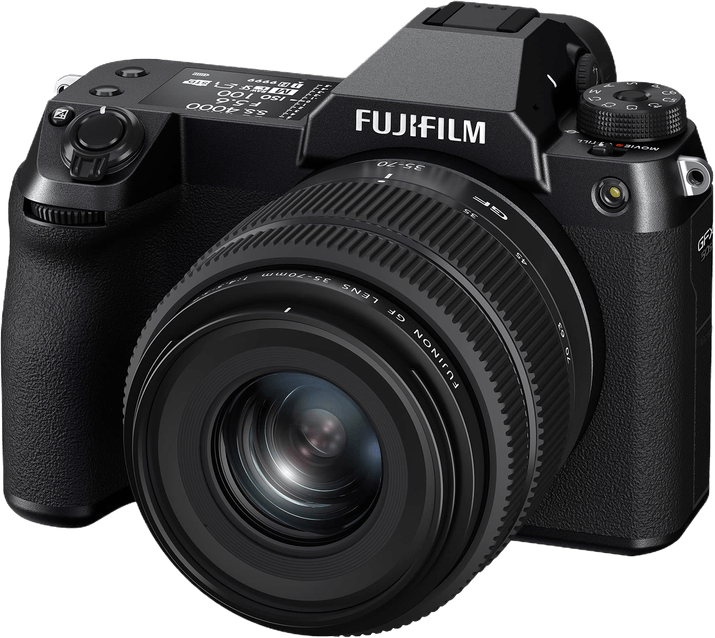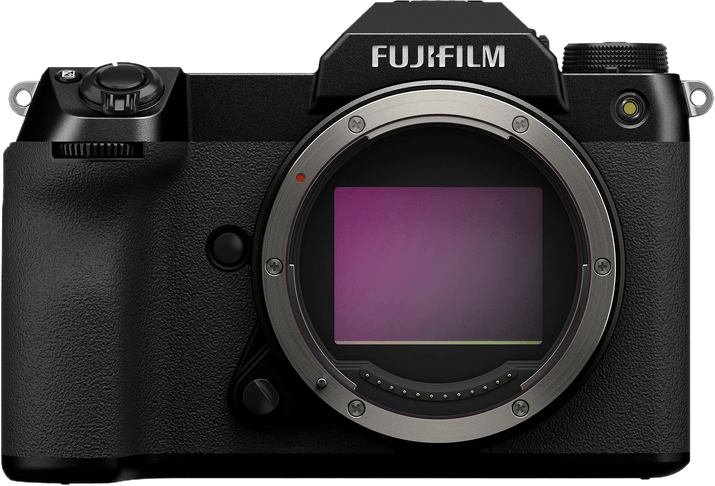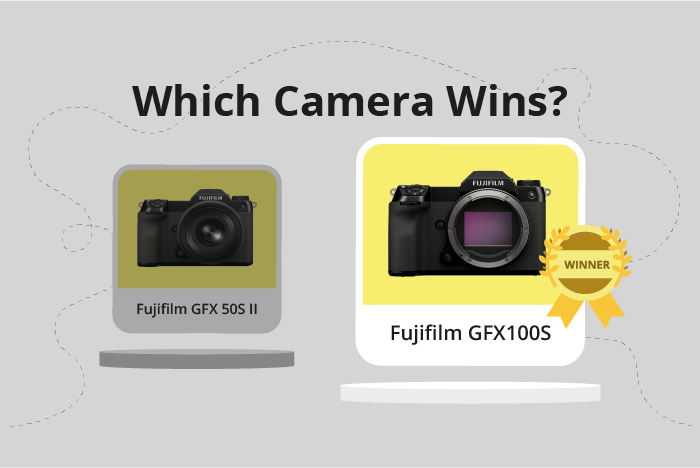Fujifilm GFX 50S II vs GFX100S Comparison
Fujifilm GFX 50S II

Fujifilm GFX100S

The Fujifilm GFX100S takes the lead with a score of 80/100, just one point ahead of the Fujifilm GFX 50S II at 79/100. Both cameras are mirrorless and share the same dimensions (150 x 104 x 87mm) and weight (900g / 1.98lbs). They were also released in 2021, with the GFX100S being announced on January 27th and the GFX 50S II on September 2nd.
The GFX100S outshines the GFX 50S II with its higher launch price of $5999, suggesting more advanced features and performance. However, the GFX 50S II has an advantage in affordability, with a launch price of $3999, making it more accessible to a wider range of photographers.
Taking these factors into account, the Fujifilm GFX100S is the better camera in terms of performance, while the GFX 50S II offers a more budget-friendly option without compromising too much on quality.
Fujifilm GFX 50S II vs GFX100S Overview and Optics
The Fujifilm GFX100S narrowly edges out the Fujifilm GFX 50S II in the optics comparison, scoring 78/100 compared to the GFX 50S II’s 77/100. Both cameras share several key specifications, including the CMOS sensor type, X-Processor 4, medium format sensor size, Fujifilm G lens mount, and image stabilization.
The GFX100S takes the lead primarily due to its significantly higher megapixel count (102) and faster shooting speed (5). The doubled megapixel count enables the GFX100S to capture more detail and produce higher resolution images, making it ideal for professional photographers and those requiring large prints. Additionally, the faster shooting speed allows the GFX100S to capture more images in a shorter time, proving advantageous for action or sports photography.
The GFX 50S II, while not as high-performing as the GFX100S, still has its merits. With 51 megapixels, it produces excellent image quality, suitable for most photography needs. The slightly lower score in optics does not necessarily mean the GFX 50S II is a poor choice; it simply reflects a small difference in performance compared to the GFX100S.
Considering the optics of both cameras, the Fujifilm GFX100S proves to be the better choice for those requiring higher resolution and faster shooting capabilities. However, the Fujifilm GFX 50S II remains a strong contender, offering solid performance in a medium format camera. Ultimately, the choice between these two cameras depends on individual needs and preferences, with the GFX100S catering to professionals and the GFX 50S II serving as a reliable option for a wider range of photographers.
Fujifilm GFX 50S II vs GFX100S Video Performance
The Fujifilm GFX100S outperforms the Fujifilm GFX 50S II in video capabilities, with a score of 83/100 compared to the GFX 50S II’s 57/100. Both cameras share some common video features, such as having built-in time-lapse functionality. However, the GFX100S has a clear advantage in terms of video resolution, dimension, and frame rate.
The Fujifilm GFX100S offers 4K video resolution, with maximum video dimensions of 4096 x 2160, while the GFX 50S II only provides Full HD video resolution, with maximum dimensions of 1920 x 1080. This difference in resolution and dimension means the GFX100S captures much sharper and detailed videos. Furthermore, the GFX100S boasts a higher maximum video frame rate of 60fps, double that of the GFX 50S II, which maxes out at 30fps. This results in smoother, more fluid video footage captured by the GFX100S.
The Fujifilm GFX 50S II does not have any specific advantages over the GFX100S in terms of video capabilities. Its lower video score reflects its inferior performance in resolution, dimension, and frame rate compared to the GFX100S.
Given the significant differences in video capabilities, the Fujifilm GFX100S is the clear winner for videographers and filmmakers who require high-quality video output. The GFX 50S II, with its lower score and limited video capabilities, is not an ideal choice for those prioritizing video performance. It is essential to consider individual needs and preferences when selecting a camera, and in this case, the GFX100S is the superior option for video recording.
Fujifilm GFX 50S II vs GFX100S Features and Benefits
The Fujifilm GFX 50S II and the Fujifilm GFX100S both have a feature score of 87/100, indicating that these cameras are quite similar in terms of their features. They share several specifications, including a 3.2-inch screen size, 2,360,000-dot screen resolution, touchscreen capability, flip screen, and the absence of GPS. Additionally, both cameras have WIFI and Bluetooth connectivity.
Despite having the same feature score, the Fujifilm GFX100S outperforms the GFX 50S II in certain aspects. The GFX100S has a higher resolution sensor (102MP) compared to the GFX 50S II (51.4MP), which allows for greater detail and image quality. Furthermore, the GFX100S offers a faster continuous shooting speed at 5 frames per second (fps), whereas the GFX 50S II is limited to 3 fps. This makes the GFX100S more suitable for capturing fast-moving subjects or action photography.
On the other hand, the Fujifilm GFX 50S II has some advantages over the GFX100S. The GFX 50S II is more affordable, making it a better option for photographers on a budget who still want to enjoy the benefits of a medium format camera. Additionally, the GFX 50S II has a slightly lighter body, which might be preferable for photographers who prioritize portability.
Considering the shared features and the specific advantages of each camera, the Fujifilm GFX100S is the better choice for photographers who require higher resolution and faster continuous shooting speed. Meanwhile, the Fujifilm GFX 50S II is an excellent alternative for budget-conscious photographers who still want to experience the benefits of a medium format camera without sacrificing essential features.
Fujifilm GFX 50S II vs GFX100S Storage and Battery
The Fujifilm GFX100S takes the lead in storage and battery with a score of 73/100, slightly outperforming the Fujifilm GFX 50S II, which scores 71/100. Both cameras share common specifications in this category, including two memory card slots, compatibility with SD/SDHC/SDXC (UHS-II) memory cards, and USB charging capabilities. They also utilize the same NP-W235 battery type.
The GFX100S has a superior battery life, providing 480 shots per charge, while the GFX 50S II offers 440 shots. This difference grants the GFX100S an advantage for extended shooting sessions. However, the GFX 50S II does not fall far behind, still delivering a respectable battery life for most photography needs.
Though the GFX100S outperforms the GFX 50S II in battery life, both cameras maintain strong storage and battery capabilities. The GFX100S’s slight edge in battery life may be a deciding factor for some photographers, but the GFX 50S II remains a solid choice with its comparable storage and battery specifications.
Alternatives to the Fujifilm GFX 50S II and GFX100S
Are you still undecided about which camera is right for you? Have a look at these popular comparisons that feature the Fujifilm GFX 50S II or the Fujifilm GFX100S:

